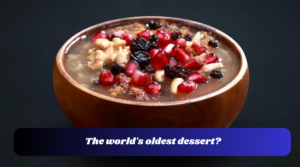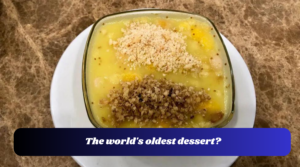Desserts, those delightful culinary creations that satisfy our sweet tooth and provide the perfect ending to a meal, have a history as rich and diverse as the ingredients used to craft them. Unearthing the world’s oldest dessert is a culinary journey that takes us back through the annals of time, revealing the sweet secrets of ancient civilizations and the evolution of our collective sweet tooth.
The Sweet Beginnings: A Love for Honey
The search for the world’s oldest dessert takes us deep into the annals of human history. When did our ancestors first develop a taste for sweetness? It is widely believed that honey, nature’s sweet gift, was one of the earliest sources of sweetness enjoyed by early humans.
Honey, a natural product produced by bees from the nectar of flowers, predates recorded history. Archaeological evidence suggests that humans began collecting honey from wild beehives as far back as 8,000 years ago. Ancient cave paintings in Spain depict honey collection, providing a tantalizing glimpse into the role of honey in the diets of our distant ancestors.
Early humans likely relished the simple pleasure of dipping fruits, nuts, or even grains into pools of golden honey. This sweet union of honey and natural ingredients can be considered one of the earliest dessert-like treats, marking the dawn of humanity’s sweet cravings.

Fruit and Nut Combinations: The Ancient Dessert Mix
As human civilizations developed, so did their culinary repertoire. The blending of dried fruits and nuts with honey or other natural sweeteners became a common practice. This ancient dessert mix served both as a source of sustenance and a sweet indulgence.
In ancient Egypt, for example, a sweet concoction called “wadj bl ntr” was created. This dessert consisted of dates, figs, and nuts mixed with honey. The combination of naturally sweet fruits and the richness of nuts provided a tantalizing contrast of textures and flavors.
Similarly, the ancient Greeks enjoyed a dessert called “pasteli,” a mixture of sesame seeds and honey. These early sweet treats highlight the enduring appeal of nut and fruit combinations throughout history.
Rice Pudding: A Timeless Classic
As civilizations continued to flourish, culinary innovations gave rise to more complex desserts. Rice pudding, with its creamy texture and subtle sweetness, stands as a timeless classic in the world of desserts.
Rice pudding has ancient origins, with evidence of its consumption dating back thousands of years in regions such as India, China, and the Middle East. These early recipes often featured rice simmered in milk and sweetened with natural ingredients like honey or jaggery.
In India, a rice pudding known as “kheer” has been enjoyed for centuries. It combines rice, milk, sugar, and aromatic spices like cardamom and saffron, creating a dessert that delights the senses.
Sesame Candy and Halva: An Eastern Delight
As we journey eastward, we discover the delightful world of sesame-based sweets. Sesame candy and halva, made from sesame seeds, honey, and sometimes spices, have been enjoyed in the Middle East and Asia for centuries.
Sesame candy, often in the form of bars or brittle, boasts a satisfying crunch and a sweet, nutty flavor. This ancient treat showcases the versatility of sesame seeds, which can be transformed into both savory and sweet delicacies.
Halva, on the other hand, is a sweet confection with countless regional variations. One common type, tahini halva, combines sesame paste with sugar or honey to create a dense, fudge-like treat. Other variations incorporate ingredients like nuts, pistachios, or flavorings such as rosewater or vanilla.
Dates Stuffed with Nuts: Nature’s Dessert
In the Middle East, where the date palm tree is abundant, a sweet delicacy was born from the synergy of nature’s offerings. Dates stuffed with nuts or other fillings are a testament to the art of simplicity in dessert-making.
This ancient treat involves removing the pit from a date and filling the cavity with nuts such as almonds, walnuts, or pistachios. The naturally sweet and chewy date pairs harmoniously with the crunch and richness of the nuts, creating a bite-sized dessert that has stood the test of time.
The Evolution of Desserts: From Simple to Sublime
While these ancient desserts provide a glimpse into the sweet past of humanity, it’s important to note that the concept of dessert has evolved significantly over time. Early desserts were often simple, relying on the inherent sweetness of natural ingredients. As civilizations advanced, dessert-making became more intricate, with the introduction of new ingredients, techniques, and cultural influences.
In Europe, the Renaissance marked a turning point in the history of desserts. Elaborate pastries, cakes, and confections began to grace the tables of the elite. The Industrial Revolution later brought mass production, making sweets more accessible to a wider audience.
Today, desserts encompass an astonishing array of flavors, textures, and styles, reflecting the diversity of cultures and ingredients worldwide. From the intricate patisseries of France to the aromatic sweets of the Middle East and the innovative creations of modern pastry chefs, desserts continue to evolve and captivate our palates.
Conclusion: A Sweet Legacy
The search for the world’s oldest dessert takes us on a journey through time, revealing the enduring human desire for sweetness and the ingenuity of ancient civilizations in crafting delectable treats. While honey, nut and fruit combinations, rice pudding, sesame sweets, and stuffed dates offer glimpses into our sweet past, the evolution of desserts showcases the rich tapestry of culinary history.
As we indulge in desserts today, whether they be time-honored classics or innovative creations, we honor the legacy of those who came before us, savoring the sweet traditions that have spanned millennia. Desserts, in all their delightful forms, remind us of the shared joy of indulging in a bit of sweetness—a tradition that transcends time and borders, uniting us in the love of all things sweet.









